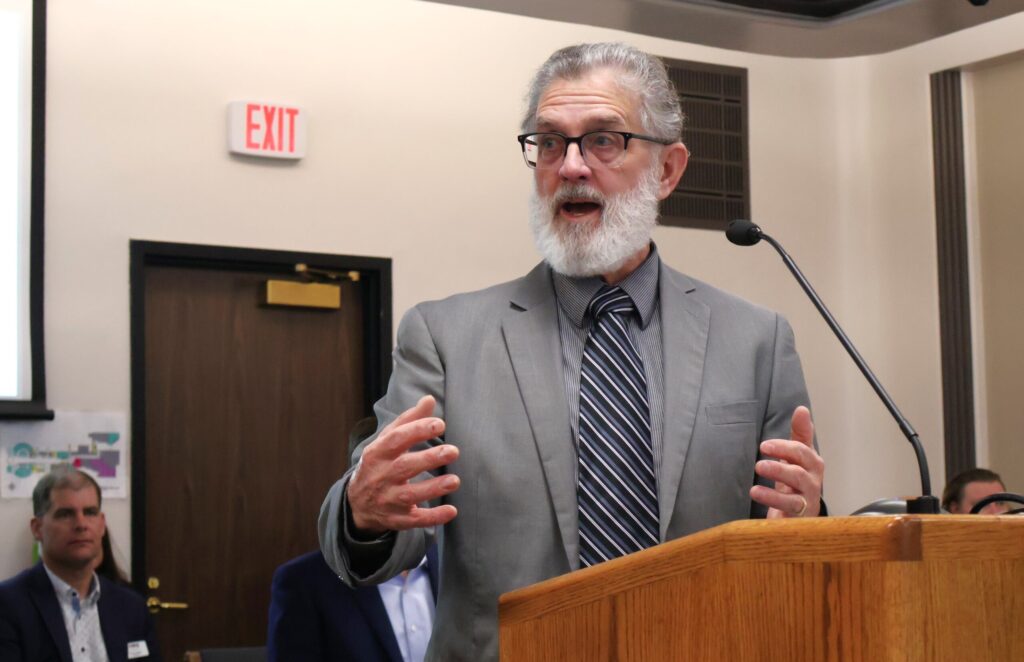Lynn Helms, director of the North Dakota Department of Natural Resources, speaks during an Energy Development and Transmission Committee meeting at the Capitol on April 10, 2024. Helms testified June 18, 2024, in federal court about the impact of a federal methane rule. (Michael Achterling | North Dakota Monitor)
A new Bureau of Land Management methane rule threatens to violate thousands of existing agreements between the federal agency and property owners, Department of Mineral Resources Director Lynn Helms testified Tuesday in federal court.
Helms, testifying on his last day before retirement, said North Dakota stands to lose $2.1 million a year in tax revenue under the new rule, and that the policy will lead to roughly 85 wells in the state to be shut down and abandoned.
The rule is in “complete conflict” with the state’s gas flaring regulations, Helms said.
North Dakota, Wyoming, Texas and Montana in April filed a lawsuit against the Department of Interior in the U.S. District Court of North Dakota arguing the new rule is an expensive and unlawful regulatory burden. Utah later joined as a plaintiff.
Attorneys representing the states in a Tuesday hearing before U.S. District Court Judge Dan Traynor argued that enforcement of the rule should be suspended as the case proceeds.
The states claim the BLM is trying to commandeer regulatory authority over flaring and air pollution that belongs to the Environmental Protection Agency and state governments.
The BLM’s new rule will require oil operators to do more to avoid wasting natural gas, like cutting down on venting and flaring and taking extra measures to detect and fix gas leaks.
Attorneys for the federal government during Tuesday’s hearing said the purpose of the new rule, in part, is to make gas flaring practices across the country more uniform.
The regulations also expand operators’ obligations to pay royalties to the federal government and tribal mineral owners when they flare gas. Based on the BLM’s own estimate, the new rule will generate more than $50 million per year in royalties.
The plaintiff states say the rule is the reincarnation of a 2016 waste management policy vacated by a Wyoming U.S. District Court judge four years ago.
That judge found the BLM had veered from its established practices and overstepped its regulatory authority. In that case, the judge denied the plaintiffs’ request for a preliminary injunction.
The federal government argued Tuesday that the new rule is much more modest than the 2016 policy. The text of the 2024 rule does acknowledge it was crafted to avoid some of the Wyoming court’s criticisms of the previous rule.
Both sides appeared to agree that the 2024 rule is expected to be much less costly to states.
The Wyoming judge’s 2020 order notes the BLM estimated that the previous rule would cost about $114 million to $279 million per year nationally.
Traynor did not appear convinced the 2024 rule is meaningfully different, however.
“How is this not the same thing with a different paint job?” he said during the hearing.
Attorneys for the federal government disagreed that the rules were incompatible with state regulations.
They also pushed back on the accusation that the agency was retroactively changing contracts with mineral owners. They said existing agreements include provisions recognizing the BLM’s authority to prevent the loss of gas through flaring.
“The rules of the road have not changed, it’s only the sign posting that’s gotten more consistent,” Erik Van de Stouwe, an attorney for the federal government, said.
Van de Stouwe accused the states of unfairly characterizing the rule as a climate-change policy “based on clandestine motives,” when it really is about royalties and preventing the unnecessary loss of natural gas loss.
He also noted that no operators have challenged the methane rule.
Traynor asked Van de Stouwe whether the BLM had consulted with the Mandan, Hidatsa and Arikara Nation about the policy considering the significant oil and gas production on the Fort Berthold reservation. There are more than 2,600 active oil and gas wells on the reservation, according to the state Oil and Gas Division, and another 2,000 could be drilled in the future.
“If there’s a harm, it’s going to harm Native people more than anyone else,” Traynor said.
Van de Stouwe said he believed the BLM did reach out to the MHA Nation for feedback on the rule.
MHA Nation Chair Mark Fox did not return a request for comment by publication time.
North Dakota produced an average of nearly 3.5 billion cubic feet of natural gas per day in April, according to preliminary figures from the state.
Ninety-five percent of that gas was captured, which exceeds the North Dakota Industrial Commission’s target of 91%.
This story was originally published by the North Dakota Monitor which is part of States Newsroom, a nonprofit news network, including the Daily Montanan, supported by grants and a coalition of donors as a 501c(3) public charity.
The post North Dakota oil regulator argues for suspension of federal methane rule appeared first on Daily Montanan.

